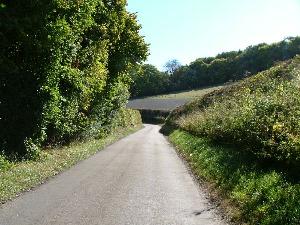Maps

Pictures

This is a picture of the magnetic hill. Stop the car on the road, facing the bend with the front of the car level with or a few metres behind the yellow sign.
Instructions
WARNING. You are on a public road! Obey all traffic signs and rules. Where there are hills there are blind spots. Always bring someone to watch for other traffic. Never try the hill when the road is wet and slippery or during inclement winter weather conditions.
With caution, position your car at a "bottom" of the hill and put your car in neutral. Take your foot off the brake and you will experience the thrill of your car not only climbing the hill by itself, but gaining speed as it goes. Look out for other traffic.
---------------------------------------------
After trying this natural phenomenon you may question it's causes. Well, we don't want to disappoint you, but whether it is called a Magnetic Hill, Gravity Hill, Mystery Hill or Electric Brae it is an optical illusion. It has nothing to do with magnetic fields, electricity or unknown forces working along mysterious lines.
Area Information
Information condensed from http://www.clintoniowa.com/goatman.html
Aston Clinton boasts an 800-year history. Nestling in the lee of the Chiltern Hills, the settlement was established at the crossing of two Roman roads. Aston, originally Estone/Eston means 'East farm'. Clinton is derived from Willelmus de Clinton who held Eston in 1208.
Local historian Mark Peers says the village's oldest building, the church of St. Michael and All Angels, has a nave and chancel built in the 13th century. In 1438, the Bishop of Lincoln complained that the bells were not rung during his pastoral visit.
In the 19th century, the Anthony Hall, now one of Aston Clinton's listed buildings, was given to the village by Lady de Rothschild in memory of her husband. It contains a painting of his two daughters Connie and Annie, who as children discovered that while boys were educated in the church school, the only school girls could attend was a place where they were taught to plait straw.
Although Connie and Annie were only 11 and nine years old, they took it upon themselves to teach the village girls other subjects. Their father, Sir Anthony de Rothschild, came to the rescue and built a girls' school. He gave Connie an infants' school as a 16th birthday present.
Information condensed from http://www.buckscc.gov.uk/about/history.htm
Have you ever wondered why Buckinghamshire is long and thin, rather than radiating from a major town or city like other counties? It is because of the county boundaries formed in the 10th century by warlords and tax collectors.
Charged with raising money to equip a new castle at Buckingham and recruiting men to fight off the invading Danes, more than 200 communities and estates were grouped together, from what was the eastern edge of the Saxon Kingdom of Wessex.
The result was a county measuring 50 miles long and 10 miles wide. After the Danes were driven out of the area, the castle in Buckingham became disused and to day you can hardly tell it ever existed.
In the early 17th century, the heavily forested woodland surrounding the Chiltern Hills was cleared - mainly for access to London. At this time great estates, such as Clivedon House and Stowe, were built.
From the 18th to 19th century, the growing railway network saw the development of industrial towns. Rail travel was also a key factor in the development of commuter towns along the commuter belt.
The unplanned outward spread of London was largely stopped in the 1930's by the creation of the Metropolitan Green Belt. This early environmental action enabled the London County Council and Buckinghamshire County Council to purchase and preserve large areas of attractive countryside.
Today the Green Belt extends to 50,000 hectares, whilst around half of the 80,000 hectares of the Chilterns Area of Outstanding Natural Beauty, fall within the county.
Since the 1960's, Buckinghamshire has been among the fastest growing areas in Britain, mainly due to the development of Milton Keynes. Milton Keynes' growing population of 207,800 resulted in it being split from Buckinghamshire in 1997, during a Local Government Review. |
Back to Top |


